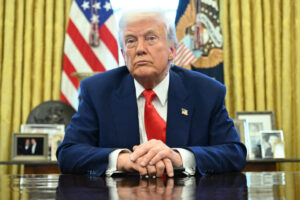The United States Space Force (USSF), introduced during President Trump’s first tenure, was widely perceived as a novel development in warfighting. Although major powers had already incorporated independent space forces or restructured their armed forces to include space-focused units, the USSF marked a significant institutional change for the United States.

The U.S.’s earliest engagement with the outer space domain was shaped by Cold War politics, during which orbital space was utilized for various reconnaissance programs supporting both the armed forces and the intelligence community. During that period, the primary concern was intelligence collection and analysis. However, this changed when space-based assets, in use since the Vietnam War, played a decisive role in the 1991 Gulf War. These assets enabled a swift and overwhelming victory, prompting the incorporation of space-based maneuvers that could deny adversaries access to their own space systems.
The restructuring of armed forces—a key element of the militarization of outer space—has been continually pursued to integrate lessons from the 1991 Gulf War and to address the evolving technological and geopolitical landscape. Created in 2019, the USSF is the sixth and newest military branch of the U.S. Armed Forces. It is tasked with organizing and training personnel for the combatant commands and safeguarding the United States’ growing space-based assets, which include military systems and vital commercial interests, particularly those of the private space sector.
Artemis Accord: Proactive Norms for Celestial Exploration
Current developments in the outer space domain, much like during the Cold War, reflect a strategy of proactively advancing both technological capabilities and normative instruments. The Artemis Program, initiated under President Trump, plans a series of missions to the Moon, with the eventual goal of reaching Mars. The United States has been negotiating the Artemis Accords with several countries to promote principles for cooperation in the peaceful civil exploration and use of the Moon, Mars, comets, and asteroids.
These proactive norms are intended to protect national interests in international forums. The Artemis Accords aim to establish a common understanding among civilian space agencies of signatory states on conducting activities in outer space. Their primary goal is to shape norms for the peaceful extraction and utilization of space resources. Strategically, the Artemis Accords challenge provisions in existing international space law that prohibited the demarcation and appropriation of celestial objects. By permitting the establishment of “safety zones” on the lunar surface, the Accords have potentially transformed the Moon into a contested space.
In the distant future, conflicts over the right to extract resources from celestial bodies may remain limited to international forums, unlike terrestrial conflicts fought over natural resources. Through the Artemis Program, co-developed with SpaceX’s Human Landing System (HLS), the United States aims to lead the next manned mission to the Moon. China, planning a similar mission by 2030, signals that the next space race will center on contested access to and exploitation of celestial resources.
The Geopolitical Role of Private Enterprises in the New Space Age
Similar to the Cold War, the modern space race has strong geopolitical undertones. However, unlike the past, today’s competition is not confined to two superpowers. The private sector, commercially available space-based assets, and emerging spacefaring nations now play significant roles in shaping the New Space Age.

Private enterprises have become crucial actors in military operations, thanks to the dual-use nature of many space technologies. Following Russia’s invasion of Ukraine, companies like SpaceX, Palantir, Planet Labs, Capella Space, BlackSky Technology, Maxar Technologies, Google, and Microsoft provided satellite communication, imagery, and cyber defense to Ukraine’s armed forces. Elon Musk’s unilateral decision to assist Ukraine was unprecedented, demonstrating the power of private individuals and corporations to influence the course of a conflict. His supply of Starlink satellite terminals enabled Ukraine to resist non-kinetic attacks and maintain operational capability.
However, the involvement of commercial satellites in conflict has also increased their vulnerability to attack. Starlink’s role in military operations has prompted China to develop countermeasures against SpaceX-provided assets. Given Elon Musk’s close ties with the Trump administration, SpaceX is likely to remain a key player in addressing national security concerns. The Starshield initiative, offering Earth observation, communications, and payload services to the U.S. government, highlights the expanding role of private actors in fulfilling functions once monopolized by the state.
United States, China, and the Politicization of Outer Space
A continuity of contingency planning across U.S. administrations has ensured predictability in space policy, which is expected to persist in Trump’s second term. The Artemis Accords and the ongoing militarization of outer space—through doctrines, strategies, and force restructuring—aim to meet current and emerging national security needs. The USSF and the broader combat readiness of the U.S. Armed Forces reflect the larger reform trends observed in China and other major powers.
China’s former People’s Liberation Army Strategic Support Force (PLASSF), which focused on cyberspace, outer space, and the electromagnetic spectrum, has now evolved into the Information Support Force (ISF). By emphasizing information technologies, China is countering U.S. dependence on space-based assets, both military and commercial. Meanwhile, China and Russia’s direct-ascent and co-orbital anti-satellite (ASAT) tests have rekindled memories of Cold War-era arms races.
Just as Cold War technological demonstrations fostered both deterrence and cooperation, today’s space competition is also prompting contested negotiations over legally binding arms control treaties. China and Russia’s disapproval of the Artemis Accords reflects broader geopolitical resistance to U.S.-led space governance initiatives.
Conclusion: Private Sector at the Heart of Outer Space Contestation
With space-based assets now integral to military operations, outer space has undeniably become a force multiplier. The prominent role of private enterprises during the 2022 Russia-Ukraine War underscores the trajectory of future warfare. The private sector is poised to:
- Influence the outcomes of armed conflicts,
- Build resilient space systems for the U.S. military, and
- Help shape international norms for space activity.
The increasing involvement of private entities in civilian and commercial missions makes them essential stakeholders in the Artemis Program. As outer space becomes a potential theater of conflict, the lack of cooperation between adversarial states like the U.S. and China could hasten such developments. With President Trump’s known skepticism toward multilateralism, the evolving roles of the USSF and the Artemis Accords may serve as platforms to challenge the normative expectations of rival states.
While norms governing strategic interests have traditionally been shaped by states, private enterprises are now increasingly driving the agenda. Their interests are becoming deeply intertwined with those of governments. SpaceX, in particular, stands to benefit if a second Trump administration prioritizes cost-cutting in civilian space missions. The reduced role of NASA in the Artemis Program could easily be supplanted by SpaceX’s Space Launch System (SLS), cementing the private sector’s central role in future space endeavors.
About the Author
Divy Raghuvanshi has submitted his Ph.D. thesis (Evolution of Norms for Outer Space: Examining the Strategic and the Political Aspects of its Militarisation) at the Department of Strategic Technologies, School of National Security Studies, Central University of Gujarat, India. He can be reached on LinkedIn.















